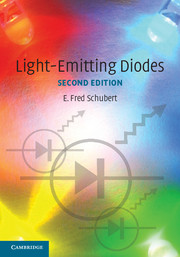Book contents
- Frontmatter
- Contents
- Preface
- 1 History of light-emitting diodes
- 2 Radiative and non-radiative recombination
- 3 Theory of radiative recombination
- 4 LED basics: Electrical properties
- 5 LED basics: Optical properties
- 6 Junction and carrier temperatures
- 7 High internal efficiency designs
- 8 Design of current flow
- 9 High extraction efficiency structures
- 10 Reflectors
- 11 Packaging
- 12 Visible-spectrum LEDs
- 13 The AlGaInN material system and ultraviolet emitters
- 14 Spontaneous emission from resonant cavities
- 15 Resonant-cavity light-emitting diodes
- 16 Human eye sensitivity and photometric qualities
- 17 Colorimetry
- 18 Planckian sources and color temperature
- 19 Color mixing and color rendering
- 20 White-light sources based on LEDs
- 21 White-light sources based on wavelength converters
- 22 Optical communication
- 23 Communication LEDs
- 24 LED modulation characteristics
- Appendix 1 Frequently used symbols
- Appendix 2 Physical constants
- Appendix 3 Room temperature properties of III–V arsenides
- Appendix 4 Room temperature properties of III–V nitrides
- Appendix 5 Room temperature properties of III–V phosphides
- Appendix 6 Room temperature properties of Si and Ge
- Appendix 7 Periodic system of elements (basic version)
- Appendix 8 Periodic system of elements (detailed version)
- Index
22 - Optical communication
Published online by Cambridge University Press: 05 September 2012
- Frontmatter
- Contents
- Preface
- 1 History of light-emitting diodes
- 2 Radiative and non-radiative recombination
- 3 Theory of radiative recombination
- 4 LED basics: Electrical properties
- 5 LED basics: Optical properties
- 6 Junction and carrier temperatures
- 7 High internal efficiency designs
- 8 Design of current flow
- 9 High extraction efficiency structures
- 10 Reflectors
- 11 Packaging
- 12 Visible-spectrum LEDs
- 13 The AlGaInN material system and ultraviolet emitters
- 14 Spontaneous emission from resonant cavities
- 15 Resonant-cavity light-emitting diodes
- 16 Human eye sensitivity and photometric qualities
- 17 Colorimetry
- 18 Planckian sources and color temperature
- 19 Color mixing and color rendering
- 20 White-light sources based on LEDs
- 21 White-light sources based on wavelength converters
- 22 Optical communication
- 23 Communication LEDs
- 24 LED modulation characteristics
- Appendix 1 Frequently used symbols
- Appendix 2 Physical constants
- Appendix 3 Room temperature properties of III–V arsenides
- Appendix 4 Room temperature properties of III–V nitrides
- Appendix 5 Room temperature properties of III–V phosphides
- Appendix 6 Room temperature properties of Si and Ge
- Appendix 7 Periodic system of elements (basic version)
- Appendix 8 Periodic system of elements (detailed version)
- Index
Summary
LEDs are used in communication systems transmitting low and medium data rates (< 1 Gbit/s) over short and medium distances (< 10 km). These communication systems are based on either guided light waves (Keiser, 1999; Neyer et al., 1999; Hecht, 2001; Mynbaev and Scheiner, 2001; Kibler et al., 2004) or free-space waves (Carruthers, 2002; Heatley et al., 1998; Kahn and Barry, 2001). In guided-wave communication, individual optical fibers or fiber bundles are used as the transmission medium and LED-based optical communication links are limited to distances of a few kilometers. Optical fiber systems include silica and plastic optical fibers. Free-space communication is usually limited to a room, even though longer distances are possible. In this chapter we discuss the characteristics of transmission media used for LED communication.
Types of optical fibers
The cross section of optical fibers consists of a circular core region surrounded by a cladding region. The core region has a higher refractive index than the cladding region. Typically, the core refractive index is about 1% higher than the cladding refractive index. Light propagating in the core is guided inside the core by means of total internal reflection. The condition of total internal reflection can be inferred from Snell's law. A light ray is totally internally reflected whenever it is incident at the core–cladding boundary.
- Type
- Chapter
- Information
- Light-Emitting Diodes , pp. 367 - 381Publisher: Cambridge University PressPrint publication year: 2006

